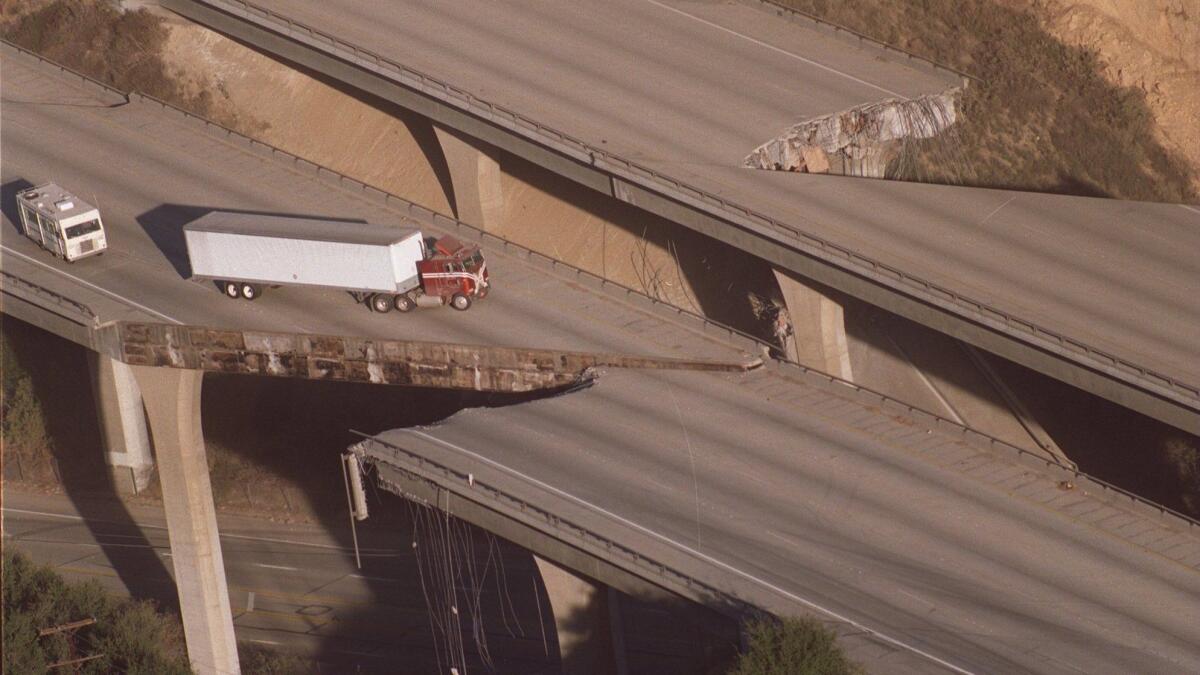Say a major earthquake will hit in seconds. How do you protect yourself?

As an earthquake warning system becomes a reality for more Californians, a big question arises: What can you do if you know shaking is coming to you?
You may only have a few seconds to act. You want to make yourself as protected as possible.
And you don’t want to be thrown to the ground where something could fall on you, like a brick wall outside a doorway or next to a glass window.
For now, the government’s suggestions are the same as what you’d do when you feel an earthquake, said U.S. Geological Survey scientist Robert de Groot.
1. In a high-rise building, office or school
Move away from windows. Drop on your hands and knees, cover your head with your arms and hold on to your neck. Hold on to a table if you can, while keeping your other arm over your head. If there’s no desk, crawl to an interior wall and cover your head and neck.
2. While driving
Pull over to the side of the road. Stop. Set the parking brake. Avoid overpasses, bridges, power lines, and signs. Remain in the car until the shaking stops. Drive carefully to avoid fallen debris and damaged pavement.
3. In bed
Don’t get out of bed. Lie face down to protect your body from falling objects. Cover your head and neck with a pillow. Keep your arms as close to your head as possible.
4. In a store
Get next to a shopping cart, under a clothing rack, or in the first level of a warehouse rack. That may help protect you.
5. Outdoors
Move away from power lines, buildings and vehicles. Then drop, cover and hold on. That protects you from anything thrown sideways at you, even if nothing is above you.
6. At the beach
To protect against the threat of tsunami, as soon as shaking ends, walk quickly to high ground or inland. Don’t wait for an official warning. Get at least 50 feet to 100 feet above sea level. If that’s not possible, stay in a sturdy concrete or steel frame building at least 50 feet to 100 feet high; a two-story wood-frame home will not be strong enough to withstand a tsunami. Review California’s official tsunami maps and find out if your favorite beach or your home is in a tsunami flood zone.
7. At a theater or stadium
Drop to the ground in front of your seat, or lean over as much as possible. Cover your head with your arms. Hold on to your neck with both hands until the shaking stops. Exit the venue slowly. Watch for anything that could fall during aftershocks.
8. Beneath a dam
Get to high ground.
9. With an infant
An adult should hold the child against their chest, drop, cover and hold on. This provides more protection above and on both sides of the baby.
10. With one or more young children
Either carry, or instruct them to drop, cover and hold on. If there’s no desk, drop to the ground and move to an inside corner of the room if possible. You and your children should be in a crawling position to protect vital organs. Practice this drill before the earthquake.
11. In a wheelchair
Lock the wheels, bend over and cover your head with your arms if possible, and hold on to your neck.
12. Beware the risks of running
Many people are hurt while trying to move during shaking. It is generally safer to drop, cover and hold on until the shaking is over, authorities say. Things just outside the exits of buildings can be at risk of falling on people near doorways.
13. The doorway is not the safest place to be in an earthquake
It’s a myth that a doorway is a safe place to be in an earthquake. (That’s only true for old, unreinforced adobe houses.) In modern homes, you’re actually at risk of the door swinging into you while you’re shaken.
Earthquake warning system will come with some false alarms and missed alerts »
More to Read
Sign up for Essential California
The most important California stories and recommendations in your inbox every morning.
You may occasionally receive promotional content from the Los Angeles Times.











